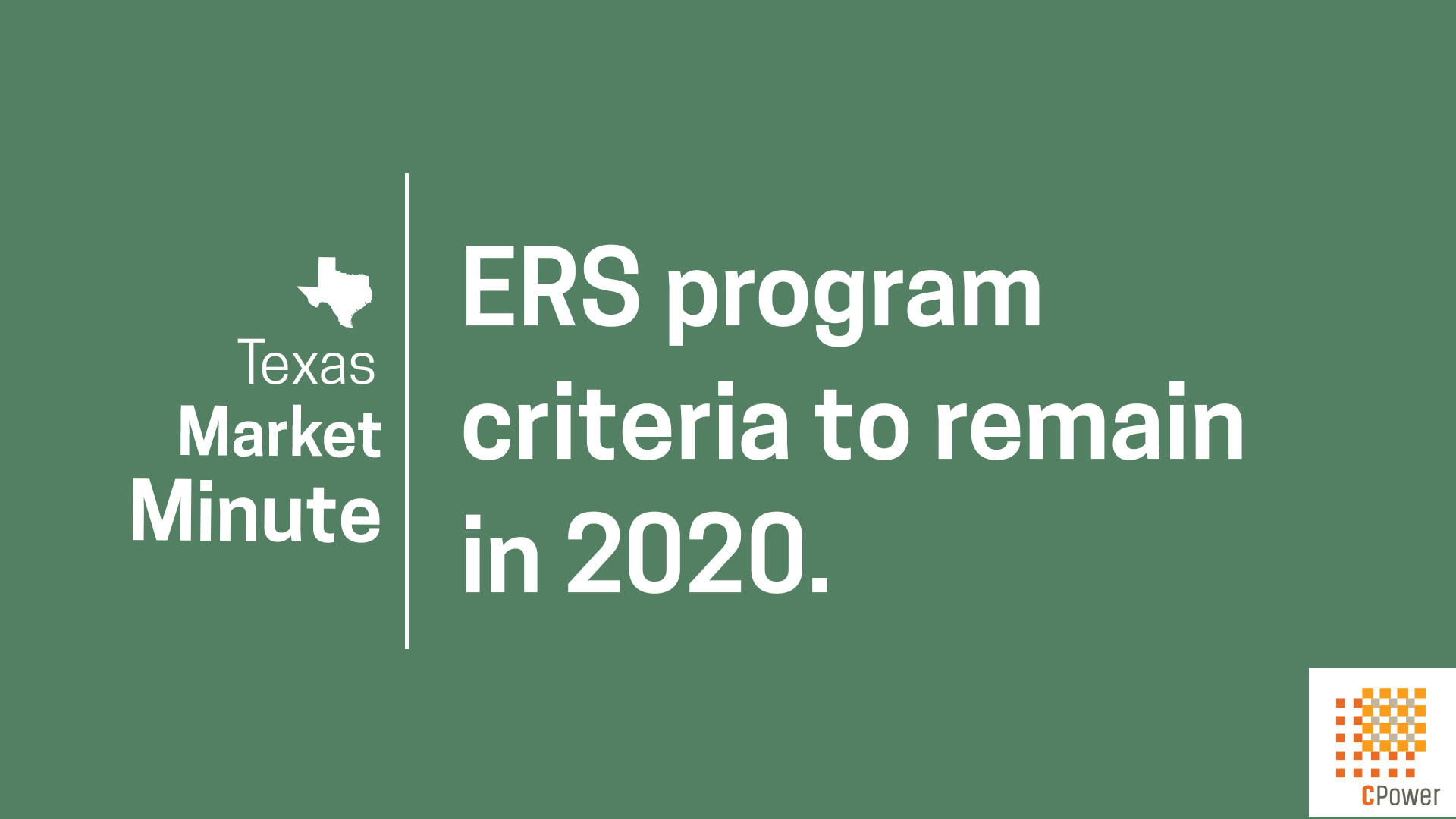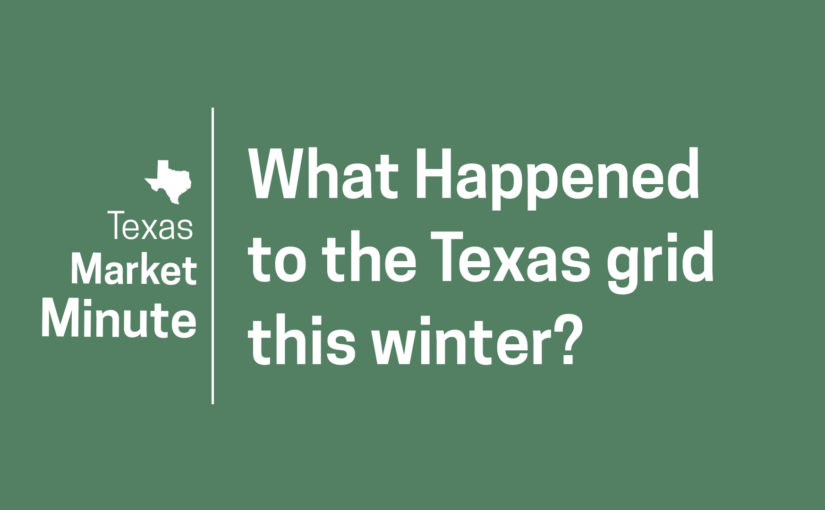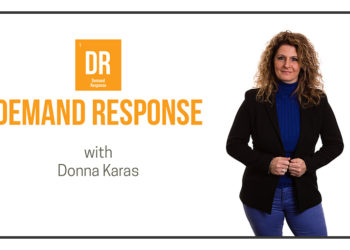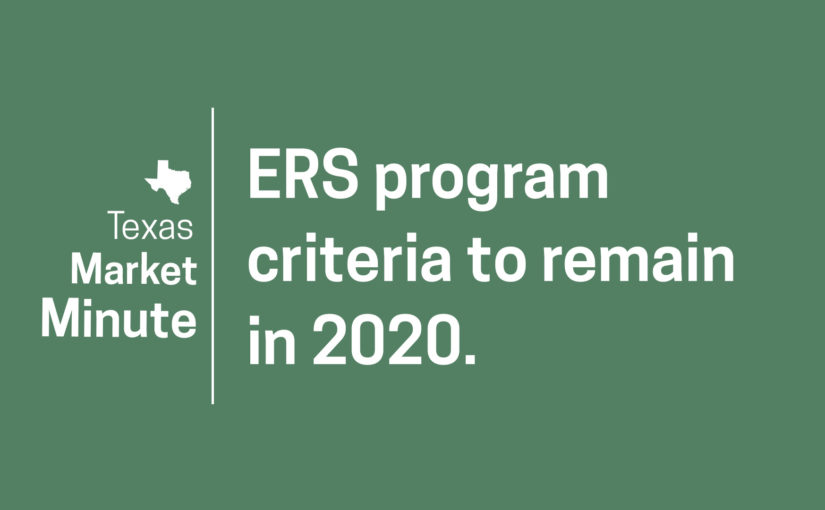The February 2021 Event in Texas: a breakdown – Market Minute (Video)

What happened during the ERCOT winter event, what’s happened since, and what may happen in the future.
The week before the event we started to see the cold weather forecasts and the projections for high demand for the following week. It was pretty clear that there were going to be demand response events on Monday and Tuesday, so we started to notify our customers of this.
Over the weekend, demand forecasts kept increasing and the situation was looking progressively worse.
Then, on Monday morning right after midnight, ERCOT called for demand response deployments and our customers responded quickly. ERCOT called both the Emergency Response Service customers and Load Resource customers which are two different demand response programs in ERCOT.
Unfortunately, there were just too many generators that were coming offline due to weather-related issues and this included essentially all types of generators such as natural gas, wind, coal, and nuclear.
You can see on the screen that grid frequency was dropping dramatically on Monday morning and that’s when ERCOT had to call for firm load shed by the utilities.
If they hadn’t done this quick enough, the grid could have gone into uncontrolled blackouts where the grid would have been down for weeks.
The grid was actually 4 minutes away from this and if the frequency had stayed below the line where the red is for four more minutes, other generators would have tripped offline and full blackouts would have occurred which would have taken weeks to recover from.
Thankfully the rolling blackouts worked and frequency recovered and stabilized the grid.
The rolling blackouts stayed in place until Thursday and the emergency was finally lifted from the grid on Friday morning around 10 am.
This next graphic compares the winter event we had in 2011 to the one we just went through.
You can see that every number on the screen is much worse for 2021 than it was in 2011.
First, the projected demand of what the grid would have been if it wasn’t for load shed is 17,000 MW higher this time. It actually would have set an all-time peak demand record, even higher than the summer.
Second, the maximum amount of generation that was offline during the event was 52,000 MW which is almost half of the total generation capacity in ERCOT. In 2011 it was only 14,000 MW. It’s tough to plan for losing almost half of your capacity during a winter storm, so that is something that’s being looked at closely in the market and how we prevent that in the future.
The other important figure here is the load shed which reached 20,000 MW during the event and this lasted for 70 hours compared to 4,000 MW of load shed for 7 hours in 2011.
Clearly, this was unprecedented.
The other note I’ll make is energy prices were at the $9,000 cap during the majority of this event. In the past, prices have only been that high for a couple of hours on summer afternoons. So, the economic fallout from this has been huge and we have seen that with some bankruptcies that have been announced.
Now, since the event has ended, there has been a lot of political fallout as well. The ERCOT CEO has resigned. All 3 PUC commissioners have resigned. Also, many ERCOT board members have resigned.
The legislature is involved as well. There are many bills that have been filed coming out of this event, but it is all still to be determined so it’s difficult to forecast what the end result will be.
We do know there will be changes, but what those changes are we just don’t know yet. A lot of the focus has been on the weatherization of the generation and natural gas supply.
CPower has supported a filing to the PUC by the trade group TAEBA to remove the $50 million cap on ERS. There has been a lot of talk about the benefit that more demand response and DERs could bring to the market and we believe that to be true.
Demand response may not have solved this event, but it certainly can help prevent other issues in the future especially as more wind and solar come on the grid.
This is a situation we’ll be keeping a close eye on at CPower, so check back to the Current for the latest updates.
A Primer for Understanding FERC Order 2222

Since being issued in September 2020, the Federal Energy Regulatory Commission’s (FERC) Order 2222 has been heralded as a landmark achievement in the history of the energy industry, one that years from now may be seen as a watershed moment when the grid took a giant leap forward in its evolution.
Before we get overwhelmed by hype and possibility, let’s take a minute to examine and clearly explain this order so your organization understands it and can use that knowledge to make an informed, educated decision on your energy use and spend.
When language matters, study the source
Language is important when it comes to interpreting and understanding energy regulations. Let us then examine FERC’s exact words concerning Order 2222 so you understand for yourself what they mean and you don’t get caught up or misled by someone else’s well-meaning and enthusiastic but perhaps not-entirely-accurate explanation of the order.
The following is verbatim from FERC,
“Order No. 2222 will help usher in the electric grid of the future and promote competition in electric markets by removing the barriers preventing distributed energy resources (DERs) from competing on a level playing field in the organized capacity, energy, and ancillary services markets run by regional grid operators.”
Order 2222 exemplifies FERC’s mission: regulate wholesale power markets
One of the Federal Energy Regulatory Commission’s primary responsibilities is to regulate the sale of electricity in the wholesale power markets, which are composed of the organized capacity, energy, and ancillary services markets that are run by the regional grid operators in the US.
To be clear, Order 2222 involves wholesale power markets, which refer to the buying and selling of power between generators and resellers. In contrast, the transaction that occurs when your organization purchases and consumes electricity takes place in the retail power market.
Order 2222 affects the wholesale power markets, NOT the retail markets.
It’s FERC’s responsibility to ensure that the competition in US wholesale power markets is just and reasonable. The markets exist to foster competition and FERC acts as essentially a referee, making sure one entity doesn’t have an unfair advantage over another.
In this respect, Order 2222 is right in the wheelhouse of FERC’s jurisdiction and mission.
Nonetheless, it is important to understand that the interconnection of DERs with the grid remains subject to local utility interconnection rules that are state jurisdictional and that these rules can encourage or discourage DER activity.
DERs are the grid’s future. Order 2222 paves a fair path forward
Until the last few years, most of the electricity entering the wholesale markets in the US originated from large traditional generation sources–coal, oil, or natural gas, for example–and was offered into the market by entities who controlled those sources, which we’ll call traditional electric resources for simplicity’s sake in this examination.
Today, however, distributed energy resources–or DERs as they’re commonly called–have become increasingly popular and have long-sought to enter the wholesale marketplace and compete alongside traditional sources.
Order 2222, as FERC clearly states, seeks to allow DERs to compete on a fair and level playing field in the wholesale power markets.
Order 2222 defines Distributed Energy Resources (for everyone)
Let’s take a moment and consider how FERC defines distributed energy resources, because this is a term that (like many in the energy industry) isn’t necessarily uniform in its definition and can mean different things to different people.
Again this language is verbatim from FERC:
“DERs are small-scale power generation or storage technologies (typically from 1 kW to 10,000 kW) that can provide an alternative to or an enhancement of the traditional electric power system. These can be located on an electric utility’s distribution system, a subsystem of the utility’s distribution system, or behind a customer meter. They may include electric storage, intermittent generation, distributed generation, demand response, energy efficiency, thermal storage or electric vehicles and their charging equipment.”
This text is worth understanding because it formally defines what has previously been nebulous and open to varying interpretations. FERC desires to create a “level playing field.”
The “level playing field” that Order 2222 seeks to create means FERC wants to make sure that assets entering the market as distributed energy resources have equal opportunity to compete against those entering the market as traditional electric resources.
If we look at FERC’s recent history of orders–including 2011’s Order 745 involving demand response resources participating in wholesale markets and 2018’s Order 841, concerning the same of storage resources–we find the Commission has been striving to establish this level playing field between traditional market participants and inevitable new players in the marketplace for some time.
What does Order 2222 do (specifically) for DERs?
At this point in our examination of Order 2222, we know FERC’s objective is to create a playing field that fosters fair competition among market participants.
Let us now take a look at the operative phrase of the order, which instructs regional grid operators to remove barriers preventing distributed energy resources (DERs) from competing on this level playing field.
A good question for us to ask now is what are these “barriers” standing in the way of DERs getting a fair shake in the wholesale markets?
The answer is complicated because the six deregulated energy markets in the US have very different rules for participation. It’s precisely those rules–or more to the point, tariffs–that Order 2222 instructs grid operators to revise, so that–again, in FERC’s words–distributed energy resources are established “as a category of market participant.”
When will we see results from Order 2222?
Back to the horse’s mouth and FERC’s wording: “Order No. 2222 takes effect 60 days after publication in the Federal Register. Grid operators must make compliance filings to FERC within 270 days of publication in the Federal Register.”
Here, we see that at the absolute earliest, the intentions of Order 2222 won’t be fully realized in the marketplace for nearly a year.
If the saga of FERC Order 841 is any indication, it will be some time before grid operators fully comply with Order 2222 and make the necessary adjustments to the tariffs that affect their markets and allow DERs the same access traditional assets have enjoyed.
It’s not unreasonable then to expect grid operators to submit appeals, file extensions (MISO, PJM, SPP, and ISO-NE have already asked for and received extensions), and otherwise take longer than 330+ days to adhere in full to FERC’s order.
On to the Future…
Order 2222 is important because it not only acknowledges the long-held conviction that DERs will play an integral role in the grid of the future, it also guarantees that in the very near future distributed energy resources such as rooftop and community solar, backup generators, fuel cells, demand response, energy storage, microgrids, and energy efficiency will take their place at the adult table in the country’s wholesale power markets.
For now, there are many ways to monetize DERs in US energy markets, especially with demand response, which pays organizations to use less energy when the grid is stressed due to lack of reliability or high electricity prices. Expect those opportunities to increase as Order 2222 is implemented.
As with all developing energy regulations, stay tuned to The Current and CPower for details as they become known.
Listen to CPower’s Director of Regulatory Affairs, Bruce Campbell, discuss FERC order 2222 and the future of distributed energy resources in the PJM market. WATCH THE VIDEO
PSC Order on NY Utility DR Program Changes for Summer 2020 – Market Minute (Video)

On May 14th, in response to COVID-19 related challenges and recommendations raised by stakeholders, the New York Public Service Commission issued an Order directing most of the utilities to implement several changes to their Dynamic Load Management (DLM) tariffs to become effective as of June 1st. These changes will impact the Commercial System Relief Program (CSRP) and the Distribution Load Relief Program (DLRP) for Summer 2020 and are intended to increase program flexibility for DR aggregators and participants.
The PSC Order directs the utilities to make the following changes to their DLM tariffs:
First, there will be an additional enrollment window to allow new participants to participate in the programs in July through September if enrollments are submitted by June 1st.
Second, for customers currently enrolled will have an opportunity to adjust their committed kW reduction amounts for July through September if this is submitted by June 1st.
Third, testing will occur only if an event has not already occurred, and the PSC has directed utilities to not administer a test before July 1st.
Lastly, for customers that have utility interval or AMI metering installed but have not been able to establish communications between the meter and the utility will be provisionally approved to participate, pending establishment of the necessary communications and providing that meter data for the CBL baseline calculations and test/event performance can be retrieved to assess program performance for settlement and payment.
These changes will be applicable to all utilities within New York, except for PSEG-LI. The PSC Order directs Department of Public Service staff to work with LIPA/PSEG-LI staff to see if similar changes can be implemented for their CSRP and DLRP programs for this program season.
If your organization is currently participating in one or both of the CSRP and DLRP programs in 2020, or had opted not to enroll in these programs due to operational and electric load changes for the season, you now have one more opportunity to enroll to participate in July through September, or to adjust your level of participation through adjusting your enrollment value.
If you have any questions or would like to enroll, or adjust your current enrollment amount, in the CSRP or DLRP programs by June 1st, or have any other New York energy question, contact CPower and we’ll help you in any way we can.
On May 14th, in response to COVID-19 related challenges and recommendations raised by stakeholders, the New York Public Service Commission issued an Order directing most of the utilities to implement several changes to their Dynamic Load Management (DLM) tariffs to become effective as of June 1st. These changes will impact the Commercial System Relief Program (CSRP) and the Distribution Load Relief Program (DLRP) for Summer 2020 and are intended to increase program flexibility for DR aggregators and participants.
The PSC Order directs the utilities to make the following changes to their DLM tariffs:
- Enrollment – an additional enrollment window has been added. New enrollments must be submitted by June 1st for participation in the CSRP/DLRP for July through September.
- Enrollment Adjustment – participants may adjust their committed kW to the CSRP and DLRP programs by submitting updated enrollments by June 1st, to become effective July 1st.
- Testing – utilities have been directed to not administer tests in their programs until July 1st at the earliest, and to not administer a test if an event has already been called.
- Metering – customers that have utility interval or AMI metering installed but have not been able to establish communications between the meter and the utility will be provisionally approved to participate, pending establishment of the necessary communications and providing that meter data for the CBL baseline calculations and test/event performance can be retrieved to assess program performance for settlement and payment.
These changes will be applicable to all utilities within New York, except for PSEG-LI. The PSC Order directs Department of Public Service staff to work with LIPA/PSEG-LI staff to see if similar changes can be implemented for their CSRP and DLRP programs for this program season.
If your organization is currently participating in one or both of the CSRP and DLRP programs in 2020, or had opted not to enroll in these programs due to operational and electric load changes for the season, you now have one more opportunity to enroll to participate in July through September, or to adjust your level of participation through adjusting your enrollment value.
If you have any questions or would like to enroll, or adjust your current enrollment amount, in the CSRP or DLRP programs by June 1st, or have any other New York energy question, contact CPower and we’ll help you in any way we can.
ERCOT Establishes the Covid-19 Electricity Relief Program – Market Minute (Video)

On March 26, 2020, the Public Utility Commission of Texas (PUCT) established the COVID-19 Electricity Relief Program, providing eligible residential ratepayers in the state with a temporary exemption from disconnections due to non-payment of electricity bills.
According to the PUCT’s draft of the Order, the program is to be funded by a rider implemented by Transmission and Distribution Utilities (TDUs).
The rider will collect funds to be utilized to reimburse TDUs and REPs for unpaid bills from eligible residential customers experiencing unemployment due to the impacts of COVID-19 and to ensure continuity of electric service for those residential customers.
All customer classes are obligated to pay this charge. The initial rider will be based on $0.33 per megawatt-hour (MWh).
The rider will have an immediate effective date upon being implemented by the TDU.
It’s not known at this time how long the charge will exist. In its Order, the PUCT has reserved the right to supplement and/or modify the relief program by a subsequent order.
This is something we’re monitoring closely, so check back with The Current or sign up to learn more as it happens.
ERCOT: ERS program criteria to remain in 2020 – Market Minute (Video)

In a recent letter to Qualified Scheduling Entities in Texas, ERCOT asserted that while the grid operator is sensitive to the distress organizations are feeling due to the current pandemic, ERCOT does NOT have the authority to alter the criteria applicable to Emergency Response Service (ERS) resources currently under contract.
If your organization is currently participating in the ERS program in 2020, you will be contractually obligated to perform under the program’s established criteria.
Some organizations in Texas are asking what happens if they can’t perform DR due to the COVID-19 pandemic.
ERCOT has stated that it DOES have the discretion to “consider mitigating factors, including Force Majeure Events, that may have impacted ERS event performance or availability when determining whether to suspend a QSE or ERS Resource that fails to meet performance or availability criteria.”
ERS participants who think they may be unable to adequately provide ERS resources as contracted should contact their Curtailment Service Provider to discuss their situation.
If you have any questions about this or any other Texas related energy question, contact CPower and we’ll help you in any way we can.
CASPR in New England – Market Minute (Video)

In New England, the second annual Competitive Auction for Sponsored Policy Resources (CASPR) took place in February 2020 for the power delivery year of 2023-24.
CASPR was created to prevent subsidized resources covered by tax credits or state incentives from depressing prices in New England’s forward capacity auctions.
CASPR was designed to allow retiring resources that had secured capacity supply obligations to transfer those obligations to new, subsidized resources that do NOT have an obligation.
The existing resource — from a retiring fossil fuel plant, for example — can then retire and receive a final payment equal to the difference between the (higher) forward capacity auction clearing price and the (lower) secondary auction clearing price.
According to ISO-NE’s published results of the February CASPR auction, zero MWs cleared the auction because there were NO retiring resources leaving the market.
This is the second year in a row the number of renewable resources seeking to ENTER the market have outnumbered the retiring resources seeking to exit the market.
ISO-New England, the region’s grid operator hasn’t committed to fundamentally changing CASPR in 2021, though there has been talk of altering auction as New England seeks to move away from a fuel mix dominated by fossil sources to one that features a greater mix of renewable sources.
For the latest insights on US energy markets by CPower, check back with “The Current” and stay ahead of energy’s demand curve.














